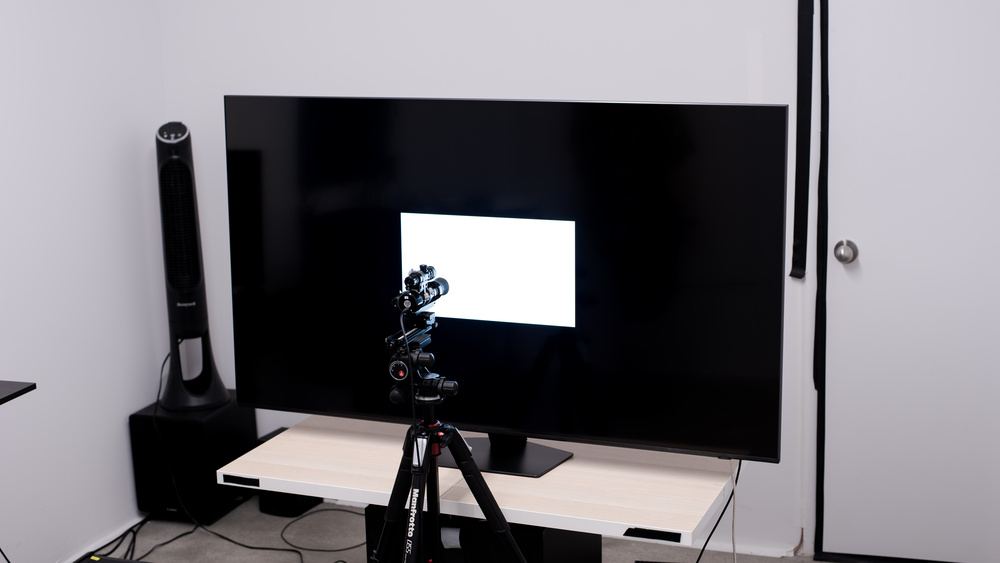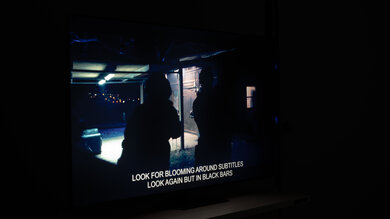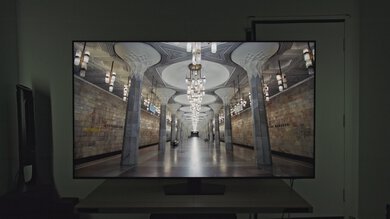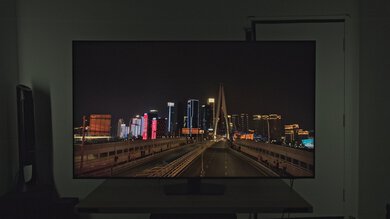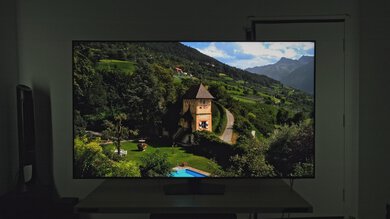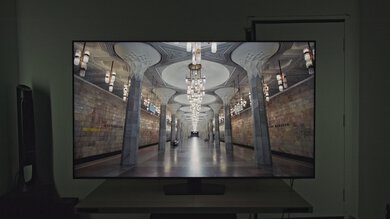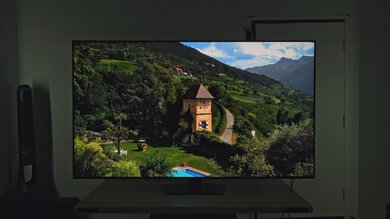The Samsung QN85D/QN85DD QLED succeeds the Samsung QN85C QLED and is Samsung's lowest Neo QLED offering in 2024, sitting below the Samsung QN90D/QN90DD QLED and the Samsung QN95D QLED. It features a Mini LED backlight, allowing for high levels of brightness and fine control over the TV's local dimming zones. It carries Samsung's Auto HDR Remastering technology, which uses AI to convert SDR content to the HDR color space. It also has an integrated microphone on both the TV and the remote, allowing for hands-free voice control through Bixby or Amazon's Alexa. It comes with Samsung's 2024 NQ4 AI Gen2 Processor, which powers the TV's image processing capabilities, as well as its Dolby Atmos sound processing. It's a fully featured gaming TV with 4 HDMI 2.1 bandwidth ports for up to 4k @ 120Hz gaming and support for every variable refresh rate (VRR) technology. It comes in 55, 65, 75, and 85-inch sizes.
Our Verdict
The Samsung QN85D is a great TV overall. Its contrast is fantastic, especially with local dimming set to 'High,' so movies look amazing in a dark room. It has good reflection handling for bright rooms, and the TV gets bright in both SDR and HDR, so TV shows and sports look great even when there are a ton of lights around. Its low-quality content smoothing does an alright job when cleaning out compression artifacts from low-bitrate TV shows and movies, but there's still noticeable macro-blocking in dark scenes. Unfortunately, the TV's viewing angle is sub-par; it's not a good choice for large viewing parties as anyone sitting to the side sees a degraded image. Aside from that, the TV has plenty of strengths: exceptionally low input lag for very responsive inputs when gaming or using a PC mouse, a ton of gaming features, and a great response time for clear motion whenever fast-moving objects are on screen.
-
Bright enough to overcome glare in a bright room.
-
Fantastic contrast and black uniformity with local dimming set to 'high.'
-
Good reflection handling, further helping it overcome glare.
-
Sub-par viewing angle.
The Samsung QN85D is good for TV shows. It has exceptional SDR peak brightness and good reflection handling, easily handling bright rooms. It also has good sharpness processing when upscaling low-resolution content, so older shows on DVDs or from streaming platforms look good. Its low-quality content smoothing is alright, so low-bitrate shows from streaming platforms don't have an excessive amount of compression artifacts, but they're still noticeable in dark scenes. Sadly, the TV's viewing angle is sub-par, so it's not a great choice for watching shows with the entire family sitting around the TV as the image degrades when viewed at an angle.
-
Bright enough to overcome glare in a bright room.
-
Good sharpness processing when upscaling low-resolution content.
-
Good reflection handling, further helping it overcome glare.
-
Sub-par viewing angle.
-
Low-quality content smoothing is alright, but there's still noticeable macro-blocking in dark scenes.
The Samsung QN85D is a good TV for watching sports. Its SDR peak brightness is exceptional, and this model has good reflection handling, so it overcomes glare in bright rooms. The TV has a great response time, so fast-moving objects like pucks or players are clear and easy to make out. The TV has good gray uniformity, so while there is some banding and vignetting on it, it's not bad enough to be annoying while watching sports with large sections of bright color. Unfortunately, the TV's viewing angle is sub-par, so anyone watching the TV at an angle sees a degraded image, which isn't optimal for large viewing parties.
-
Bright enough to overcome glare in a bright room.
-
Great response time.
-
Good sharpness processing when upscaling low-resolution content.
-
Good reflection handling, further helping it overcome glare.
-
Sub-par viewing angle.
The Samsung QN85D is a great TV on which to play games. It loses a bit of brightness and has more blooming in Game Mode, but colors still pop, and the TV looks impressive overall. The TV has excellent SDR brightness and good reflection handling, so games look bright and vibrant in even the brightest of rooms. The TV has four HDMI 2.1 bandwidth ports with up to 4k @ 120Hz support, which is great if you own multiple consoles and a PC, and it supports every variable refresh rate (VRR) technology for a nearly tear-free gaming experience. Finally, the TV has an incredibly low input lag, so your inputs are fast and responsive, and its response time is good for clear motion when gaming.
-
Bright enough to overcome glare in a bright room.
-
Incredibly low input lag.
-
Supports every variable refresh rate (VRR) technology.
-
Great response time.
-
Fantastic contrast and black uniformity with local dimming set to 'high.'
The Samsung QN85D is a great TV for watching the latest HDR movies. It has a fantastic contrast ratio, especially with local dimming set to 'High'. This means that HDR movies pop when watched in a dark room; blacks don't look gray, and highlights are bright and vibrant next to very deep blacks. Plus, the TV has excellent HDR peak brightness, so highlights look amazing in a dark room, and HDR movies on this TV can even wow in a bright room. Its low-quality content smoothing ensures that movies streamed from low-quality sources don't have excessive macro-blocking in them, although you'll still notice some in dark scenes. It also removes 24p judder from all content, so it's truly a solid choice for watching movies.
-
Completely judder-free from all sources.
-
Fantastic contrast and black uniformity with local dimming set to 'high.'
-
Great HDR brightness, so highlights pop.
-
Doesn't support Dolby Vision and DTS.
-
Low-quality content smoothing is alright, but there's still noticeable macro-blocking in dark scenes.
The Samsung QN85D is amazing for HDR games. Its HDR brightness in Game Mode is a bit dimmer than outside of it, with more blooming, but it still looks excellent in action as highlights still pop. The TV has four HDMI 2.1 bandwidth ports with up to 4k @ 120Hz support, which is great if you own multiple consoles and a PC as you can connect them all, and it supports every VRR technology for a nearly tear-free gaming experience. Finally, the TV has a great response time, ensuring motion is clear even when the action gets fast and furious.
-
Incredibly low input lag.
-
Supports every variable refresh rate (VRR) technology.
-
Great response time.
-
Fantastic contrast and black uniformity with local dimming set to 'high.'
-
Great HDR brightness, so highlights pop.
The Samsung QN85D is great when used as a PC monitor. Its reflection handling is good, and the TV has excellent brightness in SDR and amazing brightness in HDR, so it can handle any bright office. It supports up to 4k @ 120Hz on all of its HDMI ports, and it supports every VRR technology, so it's a great choice for some PC gaming. It also has an incredibly low input lag and a good response time; your inputs are fast and responsive on this TV, and there's little blur behind fast-moving objects, like when you're quickly dragging windows around on a contrasting background. Unfortunately, it has a BGR subpixel layout, which affects text clarity, although not everyone notices this. It also has a sub-par viewing angle, so the sides of the TV suffer from color shifting when you're sitting close to the screen.
-
Bright enough to overcome glare in a bright room.
-
Incredibly low input lag.
-
Great response time.
-
Good reflection handling, further helping it overcome glare.
-
Sub-par viewing angle.
- 8.1 Mixed Usage
- 7.5 TV Shows
- 7.6 Sports
- 8.4 Video Games
- 8.3 HDR Movies
- 8.5 HDR Gaming
- 8.4 PC Monitor
- Updated May 14, 2024: Review published.
- Updated May 10, 2024: Early access published.
- Updated May 02, 2024: Our testers have started testing this product.
- Updated Apr 24, 2024: The product has arrived in our lab, and our testers will start evaluating it soon.
- Updated Apr 22, 2024: We've purchased the product and are waiting for it to arrive in our lab.
Differences Between Sizes And Variants
We tested the 65-inch Samsung QN85D (QN65QN85DBFXZA), but it's also available in 55, 75, and 85-inch sizes. Note that with Samsung TVs, the six letters after the short model code (DBFXZA in this case) vary between specific retailers and regions; it's known as the QN85DBFXZC in Canada and as the QN85DBTXXU in the UK. There's also a Costco-exclusive model, the QN85DDFXZA, but it performs the same as the model sold at other retailers.
| Size | US Model | Short Model Code |
|---|---|---|
| 55" | QN55QN85DBFXZA | QN55QN85 |
| 65" | QN65QN85DBFXZA | QN65QN85 |
| 75" | QN75QN85DBFXZA | QN75QN85 |
| 85" | QN85QN85DBFXZA | QN85QN8 |
Our unit was manufactured in February 2024; you can see the label here.
Compared To Other TVs
The Samsung QN85D is a great TV with a truly fantastic local dimming feature, giving it stellar contrast and truly exceptional black uniformity when local dimming is set to 'High.' Still, the 2023 Samsung QN85C QLED is just as good, although that model uses an ADS panel versus the VA of the QN85D, giving the older model a much wider viewing angle at the cost of worse contrast. Ultimately, as great as this TV is, it's outpaced by models from brands like Hisense and TCL, as both the Hisense U8K and the TCL QM8 offer better overall performance for a lower price.
For more options, check out our recommendations for the best TVs, the best QLED TVs, and the best 4k gaming TVs.
The Samsung QN85D/QN85DD QLED and Samsung QN85C/QN85CD QLED are almost identical, with a few notable exceptions. The newer QN85D has a VA panel, giving it better contrast than the QN85C at the cost of a significantly worse viewing angle. Thus, the QN85D is better as a home entertainment option as movies look extremely punchy when watched in a dark room, while the QN85C is better for large viewing parties as its image doesn't degrade nearly as much when viewed from the sides.
The LG C3 OLED is better than the Samsung QN85D/QN85DD QLED, but they use different panel technologies. The LG is an OLED, so it has perfect contrast, making it far superior to the Samsung when viewed in a dark room. Alternatively, the Samsung's QLED panel is slightly brighter than the C3, so it's a slightly better option if you only watch content in bright rooms.
The Samsung QN90C/QN90CD QLED is a bit better than the Samsung QN85D/QN85DD QLED. The newer QN85D does have better contrast due to its VA panel, but it comes at the cost of a much worse viewing angle. Aside from that, the QN90C is brighter in HDR and SDR, has much better reflection handling, and has better color volume, making it look punchier than the QN85D.
The Sony X90L/X90CL and Samsung QN85D/QN85DD QLED are equally as good, with a few differences between them. The Samsung has the better contrast of the two, with far better black uniformity, so it's the clear winner for dark room content. Alternatively, the Sony has far superior image processing, so it's better than the Samsung when watching low-resolution or low-bitrate content.
The LG C4 OLED is better than the Samsung QN85D/QN85DD QLED, but they use different panel technologies. The LG is an OLED, so it has perfect contrast, making it far superior to the Samsung when viewed in a dark room. The Samsung TV's QLED panel is brighter than the C4 in SDR content and in Game Mode when playing games, although the LG isn't far behind. Ultimately, the LG is the better product, except perhaps for those who almost exclusively watch SDR content in very bright rooms.
The Samsung S90C OLED is better than the Samsung QN85D/QN85DD QLED, but they use different panel technologies. The S90C is an OLED, so it has perfect contrast, making it far superior to the QN85D when viewed in a dark room. It also has far better reflection handling and a significantly wider viewing angle than the QN85D. The QN85D is, however, noticeably brighter in SDR content, but unless you exclusively watch SDR content, the S90C is the better choice.
The Samsung QN95C QLED is a bit better than the Samsung QN85D/QN85DD QLED. They're very similar, but the QN95C has the edge in almost every category; it gets brighter in HDR and SDR, it has better reflection handling, a wider viewing angle, better black uniformity, and can do up to 4k @ 144Hz while the QN85D is limited to 120Hz.
The Hisense U8/U8K is better than the Samsung QN85D/QN85DD QLED. The Hisense is far brighter in HDR and SDR, with a wider color gamut and much better reflection handling, so it looks significantly more vibrant in bright rooms. The Hisense also looks better in dark rooms due to its better black uniformity. The Samsung does have a slight edge in response time, but for gamers, the Hisense compensates by offering up to 4k @ 144Hz support, while the Samsung is limited to QN85D. Ultimately, the Hisense is the better product.
The Samsung S90D/S90DD OLED is better than the Samsung QN85D/QN85DD QLED, but they use different panel technologies. The S90D is an OLED, so it has perfect contrast, making it far superior to the QN85D when viewed in a dark room. The S90D is also a bit brighter than the QN85D in HDR, although the latter has a clear edge in brightness in SDR content. The S90D also has far better reflection handling and a significantly wider viewing angle, so ultimately, it's just in a different league than the QN85D.
The Samsung QN85D/QN85DD QLED is better than the Samsung Q80C QLED. The QN85D is better than the Q80C in every notable category, so it looks far better in every context, with one exception: the Q80C has a far wider viewing angle, so if you're specifically buying a TV to host large viewing parties, then the Q80C is perhaps the better option, even with the QN85D's obvious edge in image quality.
The TCL QM8/QM850G QLED is better than the Samsung QN85D/QN85DD QLED. The TCL is incredibly bright, much brighter than the Samsung in HDR and SDR, so it looks far more vibrant in bright rooms. The TCL is also better for gamers with its faster response time and 4k @ 144Hz support, although it does have quirks with its VRR performance. The Samsung is, however, the more accurate TV of the two in HDR and SDR, so if accuracy matters to you, it could be the better option.
Test Results
The Samsung QN85D has a nice design, although it looks like a much thicker version of last year's Samsung QN85C/QN85CD QLED. From the front, it has thin bezels and a sleek look that'll fit in any room.
The Samsung QN85D's center-mounted stand is small and doesn't take up much space, so the TV doesn't require a large table or desk. The stand's small size doesn't stop the TV from wobbling, but it's not concerning.
Footprint of the stand on the 65-inch model: 15.2" x 11.2". The stand lifts the TV about 3.15 inches above the table, so most soundbars fit in front of the TV without blocking the screen.
The back of the TV looks good, with a nice textured design. There are slots on each side of the TV for alternate feet, but no alternate feet are included in the box. There are cable channels on the back to help with cable management. There are also cable grooves in the stand, hidden with a cover, to further channel cables towards the stand's bottom and out of the TV. Note that the TV's inputs are in a recessed inlet on its back panel. They're hard to access if you wall-mount the TV with a fixed bracket.
The build quality of the Samsung QN85D is great. The TV wobbles from front to back and from side to side due to its small stand, but it's not concerning. However, there's a large amount of flex near the TV's VESA holes and its inputs; it's pretty typical, but it's something to note. Aside from that, the TV feels sleek and is made from premium plastic.
The Samsung QN85D has a fantastic contrast ratio and is a big improvement over last year's model. Its native contrast ratio is good, but with local dimming set to high, its contrast ratio is stellar; the TV can produce extremely deep blacks that don't look gray when viewed in a dark room, and blacks stay deep when bright highlights are on screen.
Lighting zone transitions on the Samsung QN85D are decent, but the algorithm that controls the local dimming feature can't quite keep up with fast content, so transitions are noticeable. When bright highlights move quickly across the screen, the leading edge is darker due to the TV not turning on zones fast enough. There's also a bright halo behind bright highlights that move quickly across the screen.
The TV's HDR peak brightness is excellent. Small specular highlights stand out very well, and while large bright scenes are dimmer, they're still very bright. The TV's Automatic Brightness Limiter (ABL) isn't aggressive at all, so variations in brightness are kept to a minimum, although they're still there.
These measurements are after calibrating the HDR white point with the following settings:
- HDR Picture Mode: Filmmaker
- Brightness: 50 (Max)
- Contrast: 50 (Max)
- Contrast Enhancer: Off
- HDR Tone Mapping: Static
- Color Space Settings: Auto
- Peak Brightness: High
- Color Tone: Warm2
The TV's peak HDR brightness in Game Mode is slightly lower than in 'Filmmaker,' but it's still great. Highlights still pop, although with more blooming than in other picture modes.
These measurements are after calibrating the HDR white point with the following settings:
- HDR Picture Mode: Game
- Game HDR: Basic
- Brightness: 50 (Max)
- Contrast: 50 (Max)
- Contrast Enhancer: Off
- HDR Tone Mapping: Static
- Color Space Settings: Auto
- Peak Brightness: High
- Color Tone: Warm2
The Samsung QN85D's PQ EOTF tracking is superb in 'Filmmaker' mode. It does behave strangely in brighter midtones, as it suddenly dips below the curve, indicating that midtones are too dark. The curve also behaves erratically after the TV hits its peak. The curve is more typical when testing with an industry-standard 10% window, as seen here. Still, this indicates that some highlights might look weird depending on the scene.
Overall, the TV follows the curve extremely closely. There's a slight roll-off with content mastered at all levels when the TV reaches its peak brightness, preserving bright detail in highlights.
The TV's SDR peak brightness is excellent. It's bright enough to overcome glare in even extremely bright rooms with lots of natural light. The TV's Automatic Brightness Limiter (ABL) is not aggressive, although large, bright scenes are still dimmer than scenes with smaller highlights. However, despite the ABL, the TV is still bright enough to overcome glare.
These measurements are after calibration with the following settings:
- Picture Mode: Movie
- Brightness: 50 (Max)
- Color Space: Auto
- Color Tone: Warm2
- Peak Brightness: High
The Samsung QN85D has an excellent color gamut. It can display almost the entire range of colors in the widely used DCI-P3 color space, so HDR content is vivid and lifelike, although most colors are slightly undersaturated. It has good coverage of the Rec. 2020 color space, although some colors are notably off, in particular greens and cyans.
The Samsung QN85D has great color volume. It has bright, vibrant colors and can display bright colors very well, although it's not quite as vibrant as last year's Samsung QN85C/QN85CD QLED.
The TV has very good pre-calibration accuracy, although the 'Auto' color space setting doesn't properly clamp the TV's colors to the Rec. 709 space, leading to slightly oversaturated colors. Still, its white balance is excellent, although brighter whites have too much color in them, and its color temperature is just a tad colder than the calibration target of 6500K. Its gamma, however, is way too bright in brighter scenes.
After calibration, the TV has excellent accuracy, although the color space bug persists, as the 'Auto' color space setting still doesn't clamp the TV's color to the Rec. 709 space correctly. Thus, even after calibration, the TV's colors are slightly oversaturated. Still, its white balance, color temperature, and gamma are now right on the calibration target, although it requires some aggressive tuning since the gamma is so overbrightened to start with.
You can see our full calibration settings here.
The TV has good gray uniformity. There's some vignetting, where the sides of the image are slightly darker than its center, and vertical banding is noticeable in content with large sections of bright colors, like when watching sports like hockey. However, its uniformity with very dark colors is excellent.
The TV's black uniformity is amazing. With local dimming set to 'High,' there's some noticeable blooming around bright elements, but the image is pitch black outside of that. If you turn off local dimming, the entire image will be blue or grayish when bright highlights are present.
Unfortunately, the Samsung QN85D has a significantly worse viewing angle than any other QN85 series TV in the past three years. There's very noticeable color washout and brightness loss in the image when viewed at an angle.
The Samsung QN85D has excellent HDR gradient handling. However, there's very noticeable banding in dark blues and minor banding in dark grays, reds, and greens, as well as in brighter blues. Light grays and reds are free of any banding.
The TV has good sharpness processing when upscaling content. It's good enough that low-resolution content looks sharp, although you lose some fine details in the process.
Sharpness processing was calibrated with no over-sharpening for low-resolution content, with the following settings:
- Sharpness: 5
- Picture Clarity: Off
Unlike past models in the QN85 series, the Samsung QN85D uses a VA panel instead of ADS/IPS. This gives it better contrast at the cost of a worse viewing angle. Furthermore, the QN85D has a Blue-Green-Red (BGR) subpixel layout. For multimedia usage, this doesn't cause any issues, but it causes text clarity issues when you use this TV as a PC monitor. There are easy workarounds for these issues, however, and you can read about them here.
The Samsung QN85D uses pulse width modulation (PWM) to dim its backlight, so unfortunately, it's not flicker-free. The flicker frequency varies between picture modes and at different brightness settings. Below max brightness, 'Movie' mode flickers at 960Hz, while 'Game' Mode and 'Filmmaker' mode flickers at 120Hz. At max brightness, all three are flicker-free. Standard, Eco, and Dynamic flicker at 120Hz at any brightness setting.
The TV has an optional backlight strobing feature, commonly known as black frame insertion (BFI). The feature helps reduce blur caused by the TV's fast response time, otherwise known as persistence blur. It works at both 60Hz and 120Hz, which is great, but unfortunately, its timing is off, and it causes a duplicate image when enabled.
The Samsung QN85D has a feature to increase the frame rate of low frame-rate content up to 120Hz. As is typical of this feature, it works very well with slow panning shots and other slow-paced scenes but shows a lot of artifacts once the action ramps up.
Due to the TV's great response time, low frame rate content, like movies, stutters a bit. It's mainly noticeable in slow-panning shots, and motion interpolation or backlight strobing features can mitigate this to some degree, but they come with their own problems.
The Samsung QN85D automatically removes judder from any source, with no additional settings needed. As a result, motion appears smooth, making it great for watching movies.
The Samsung QN85 series is compatible with all three variable refresh rate (VRR) formats, and it works across a very wide refresh rate range, which ensures that your games remain nearly tear-free when gaming. It also supports sources with Low-Frame-Compensation (LFC), which ensures your games remain nearly tear-free even when your frame rate drops very low.
Unfortunately, there's an issue when using AMD graphics cards where the LFC doesn't activate when the frame rate drops below 48fps.
The TV has extremely low input lag in Game Mode. It results in a very responsive gaming experience, with very little delay between your inputs and the on-screen action. Unfortunately, the input lag outside Game Mode is too high for gaming or PC use.
The TV supports most common resolutions up to 4k @ 120Hz. All supported formats display chroma 4:4:4 signals properly, which is essential for clear text from a PC. There are no resolution-halving issues on this TV at any resolution.
The TV doesn't natively support 1440p @ 120Hz when connected to an NVIDIA graphics card (GPU). If the card's scaling features are enabled, then the card scales the 1440p input to the TV, but with scaling disabled, the TV just displays a windowed version of 1440p with black bars around it. No such issue happens with AMD cards, as the TV natively supports 1440p when connected to these cards.
The Samsung QN85D is fully compatible with everything the PS5 offers, like 1440p @ 120Hz and 4k @ 120Hz, as well as HDMI Forum VRR. It also supports Auto Low Latency Mode, so you don't have to worry about switching to Game Mode to get the lowest input lag.
The TV is fully compatible with almost everything the Xbox Series X|S offers, including 4k @ 120Hz, HDMI Forum VRR, and FreeSync Premium Pro. It also supports Auto Low Latency Mode, so you don't have to worry about switching to Game Mode to get the lowest input lag. Unfortunately, the TV doesn't support Dolby Vision.
The Samsung QN85D supports full HDMI 2.1 bandwidth on all four HDMI ports, making it very flexible for users with multiple HDMI 2.1 devices. Unfortunately, Samsung still doesn't support Dolby Vision; instead, it supports the less widely used HDR10+ format.
This TV supports eARC, which lets it pass uncompressed high-quality audio from a connected source to your receiver without sacrificing audio quality. Sadly, it doesn't support DTS audio formats, which is disappointing as many UHD Blu-rays and DVDs use DTS for their lossless audio tracks.
The TV's frequency response is okay. There's a bit of bass on the TV, and it sounds sharp and clear at moderate volume. However, when you raise the volume near or at max, the TV's sound reproduction shows noticeable compression, with dialogue not sounding as clear.
The TV's distortion handling is okay. While its performance is very good at moderate volume levels, distortion is more noticeable at higher volumes.
The Samsung QN85D runs the 2024 version of Tizen OS, which is easy to use. Unfortunately, at times, the interface is slow to open for no obvious reason, and sometimes, the TV doesn't register when you change the input label, requiring you to do it again.
The TV has a great selection of apps, so it's easy to find your favorite content. You can also cast content from your phone onto the TV or play videos from a USB stick.
The TV comes with a slim remote that is easy to use. It's minimalistic, with few intuitively laid-out buttons. It has a built-in rechargeable battery, which you can charge through USB-C, with a port on the bottom of the remote or through the solar panel on the back of the remote. The TV is compatible with Bixby and Amazon's Alexa, and both the remote and TV have integrated microphones. The voice commands work well; you can tell the TV to change inputs, ask it to open apps, or even change the brightness. Unfortunately, you can't search for content within apps using voice.

